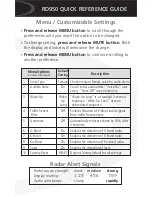
4
Fig. 2.2. The shape of the radiated electromagnetic wave
These electromagnetic waves propagate in the sounding medium, reflecting from the
sections of the media and various (metals, cavities, various objects, layer boundaries with
different parameters, etc.). The reflected signal is received and registered by the GPR
receiver. But in addition to the reflected wave, there is also a direct wave that goes directly
from the transmitting antenna to the receiving antenna along the shortest path. Therefore,
at the output of the receiver, the signal is a transmitter pulse (as in Fig. 2.2.) and the
reflected pulses following it. It is necessary to estimate the delay time of the reflected
signals from this transmitter pulse in order to determine the depth of the target in the
medium.
Signals characteristics depend on the antenna, transmitter power (Tx), environmental
conditions and receiver parameters (Rx) from the moment the transmitting antenna is
excited until the reflected signal reception. All of these parameters affect the overall
dynamic range of the entire system. There have been various methods for digitizing analog
signals since the advent of digital technologies. One of the main methods used in pulsed
georadars are the stroboscopic method and the Real Time Sampling method, or their
symbiosis. Also, the structure of the GPR itself and of antenna systems used with it, or
rather, the choice of an analog-to-digital converter (ADC), as the main element for
converting an analog signal to digital, depends on the chosen method of digital conversion.
Fig. 2.3. Received signal example
The transmitter pulse is clearly visible on the left
The process shown in Fig. 2.3 is very fast and takes units or hundreds of
nanoseconds and is technically difficult to process. One of the first solutions was the use of
the stroboscopic method of signal digitizing (Fig. 2.4.), as in the “
Zond-12e
” and
“
Python-3
” GPR families. The stroboscopic method is based on the thesis that the GPR
and its antenna are in the same place for a relatively ultra-short millisecond time interval.
And accordingly, within these limits, the characteristics of the environment and equipment
are not changing. So, if a wave with the same power is emitted by the transmitting GPR






































